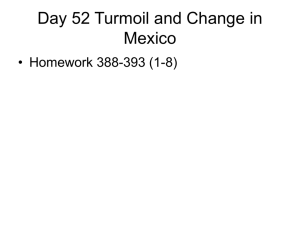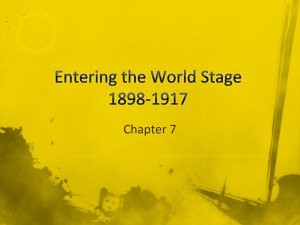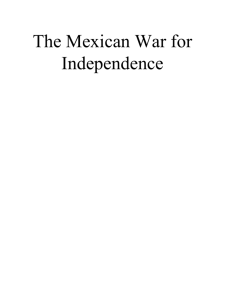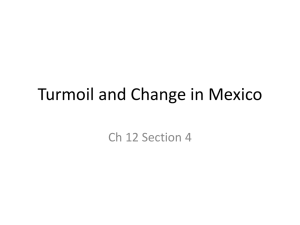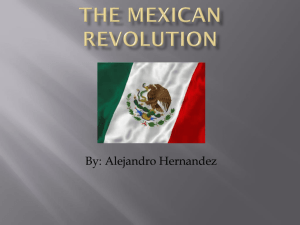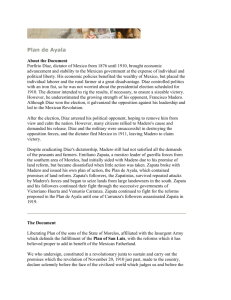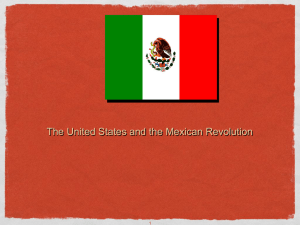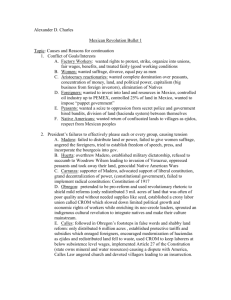LA Notes Day 3
advertisement
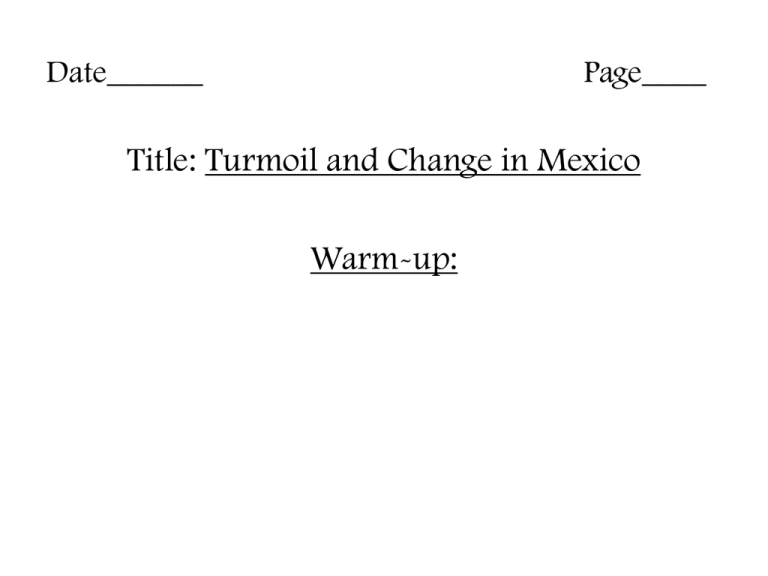
Date______ Page____ Title: Turmoil and Change in Mexico Warm-up: MEXICO Revolutionary Mexico Video 1.Who was Father Hidalgo? ***Leave space for Augustin Iturbide notes here*** 2. How did independence from Spain affect the lives of poor Mexicans? ***Leave space for Santa Anna notes here*** 3. What was the result of the Mexican-American War? 4. What did Benito Juarez accomplish? 5. How did Porfirio Diaz stay in power for so long? 6. Why did the 1910 Revolution occur? 7. What was the Plan of Ayala? 8. Why were Emilio Zapata and Pancho Villa opposed by the United States? 9. What was the Cristero War? 10. What did Lazaro Cardenas accomplish in 1938? 11. What is the North American Free Trade Agreement? 12. Who was elected president in Mexico’s 2000 presidential election? 1. Who was Father Hidalgo? • A Mexican Roman Catholic priest and revolutionary rebel leader of mestizos & Native Americans. • He is regarded by most Mexican people as the "Father of the Country“. • The founder of the Mexican War of Independence movement which fought for independence from Spain in the early 19th century. • Was executed & had his head on display by the Spanish until 1821 · Agustin Iturbide • (1822 – 1823) Mexican ruler • Declares independence from Spain after a change in government there threatens Creole power • Iturbide is eventually overthrown & Central America declares independence from Mexico Antonio Lopez de Santa Anna • (1821) Fought for Mexican independence from Spain • (1829) Fought Spain again when they tried to recapture Mexico • Served as Mexico’s President 4 times (1833 – 1835; 1839) • (1836) Defeated Texans at The Alamo, but could not prevent Texas independence • (1846-1848) Lost the Mexican War with the United States & forced to give up the Mexican Cession Colonel William B. Travis Jim Bowie Davy Crockett (Commander of the Alamo) : One of the first to fall, he died defending the north wall at an early hour on March 6. He was 26 years old. (Co-commander of the Answered Travis’s call for help in defending the Alamo Alamo): Killed in his bed, along with other volunteers. His body was found in where he laid sick with small fort in the west side. He was 50 years old. pneumonia, in a small room in the south side. He was 41 years old. Bowie Knife Texas Flag That Flew Over The Alamo General Antonio López de Santa Anna 12 inches (30cm) or more, with a broad blade that was an inch and a half to two inches wide (4 to 5 cm) and made of steel 2. How did independence from Spain affect the lives of poor Mexicans? • Industrial growth did not benefit most Mexicans. • Economic inequality still existed. • Large landowners controlled haciendas which employed poor farmers. • Foreigners became wealthy by owning Mexican property. 3. What was the result of the MexicanAmerican War? 3. What was the result of the MexicanAmerican War? 4. What did Benito Juarez accomplish? • (1867 – 1872) President • Wanted to improve conditions for the poor in Mexico. • Led the movement called La Reforma which aimed to: • Break the power of the large landowners • Improve education to the poor • Napoleon III tried to conquer Mexico for unpaid debts & Juarez defeated the invasion force. 5. How did Porfirio Diaz stay in power for so long? • (1876 – 1880) & (1884 – 1911) • Brought order to Mexico • Ended raids by bandits • Brought some economic growth (encouraged foreign investments) • Limited political freedom however 6. Why did the 1910 Mexican Revolution occur? Causes: • 31-year dictatorship of Diaz • No democracy; people could not vote • Economic inequality: wealth & land in the hands of the few • No freedom of speech • High taxes • High unemployment Causes: • Diaz called for elections, but then imprisoned his main rival Francisco Madero, who believed in democracy • Madero escaped to the United States in 1910. • He declared that the elections had been a fraud and that he would not recognize Diaz as the legitimate President of the Republic. • Madero declared himself President until new elections could be held. • Madero promised to return all land which had been confiscated from the peasants, and he called for universal voting rights and for a limit of one term for the president. The Mexican Revolution • Madero's call for an uprising on November 20th, 1910, marked the beginning of the Mexican Revolution. • Madero was able to persuaded Francisco “Pancho” Villa to join the revolution. • Villa proved to be an excellent strategist, and he earned the allegiance of the people of the NORTH, who were particularly unhappy about the abusive ranchers and landlords who ran the North. The Mexican Revolution •Emiliano Zapata led the uprising of the peasants of the SOUTH to claim their rights over local land and water. • At the same time, armed revolt began in many other parts of the country. • Diaz’s army was defeated within six months & he resigned. Madero • (1911 – 1913) President • With the collapse of the Diaz regime, the Mexican Congress called for national popular elections, which resulted in the victory of Madero as President. 7. What was the Plan of Ayala? • Zapata denounced President Madero for his betrayal of the revolutionary ideals. • Madero demanded Zapata's army disarm as a precondition for discussion of the land issue. • After Madero supported plantation owners and failed to settle the land issue to Zapata's satisfaction, the peasant leader mobilized his army again. • Zapata called for new elections & redistribution of land Huerta • (1920) President • Madero was soon overthrown by General Victoriano Huerta, who granted amnesty to Díaz and suppressed resistance to land reforms. • Murdered Madero in February of 1913. 8. Why were Emilio Zapata and Pancho Villa opposed by the United States? • Zapata & Villa threatened American business interests in Mexico. Venustiano Carranza • (1914 – 1920) President • Carranza, Zapata & Villa overthrew Huerta’s government. • Carranza then turned on the revolutionaries & murdered Zapata. • The civil war ended with over 1 million Mexicans dead. Zapata's dead body on display on the day he died. Alvaro Obregon • (1920 – 1924) President • Carranza did not support the new constitution. • Obregon overthrew Carranza in 1920. • Obregon supported the reforms of the new constitution. 9. What was the Cristero War? (1926 – 1929) • A counter-revolution against the anti-Catholic Mexican government of the time, caused by the anti-clerical provisions of the Mexican Constitution of 1917. • Violence began on January 1, 1927 with the rebels calling themselves Cristeros because they felt they were fighting for Christ Himself. • Just as the Cristeros began to hold their own against the federal forces, the rebellion was ended by diplomatic means, brokered by the U.S. 10. What did Lazaro Cardenas accomplish in 1938? • (1934 – 1940) President • Land reform • Labor rights (unions) • Nationalized the oil industry • Kicked out foreign oil companies 11. What is the North American Free Trade Agreement? (1994) • Trilateral trade bloc created by the United States, Canada & Mexico. • Eliminated tariffs & trade restrictions among the 3 nations. NAFTA – North American Free Trade Agreement United States President Bill Clinton signing NAFTA into law, November 1993. NAFTA – Positive Effects: 1) Created the world’s largest free trade area, linking 439 million people and producing $15.3 trillion in goods and services annually. 2) Eliminated tariffs and agreements on international rights for business investors. 3) Increased trade & capital = business growth. 4) Elimination of tariffs also reduces inflation, by decreasing costs of imports. 5) Trade between the 3 NAFTA nations tripled, from $297 billion in 1993 to $903 billion in 2007. 6) U.S. goods exports to Canada and Mexico grew 157%, from $142 billion to $364.6 billion. 7) Exports from Canada and Mexico to the U.S. grew 231%, from $151 billion in to $501 billion. NAFTA – Negative Effects: 1) Since the cost of labor is cheaper in Mexico, many industries moved part of their production from high-cost U.S. states. 2) Between 1994 and 2002, the U.S. lost 1.7 million jobs but gained 794,00 jobs, for a net loss of 879,000 jobs of which 78% were in manufacturing. 3) States hit particularly hard include CA, NY, MI, & TX. These states have high concentrations of industries (such as motor vehicles, textiles, computers, and electrical appliances) which moved a large number of plants to Mexico. 4) Lower U.S. wages > Companies threaten to move south if unions demand higher wages 5) Mexican farmers are being put out of business > U.S. agribusiness 6) Mexican workers are exploited > Mexico’s weak labor laws 7) Mexico's environment has suffered > Mexico’s weak environmental laws
